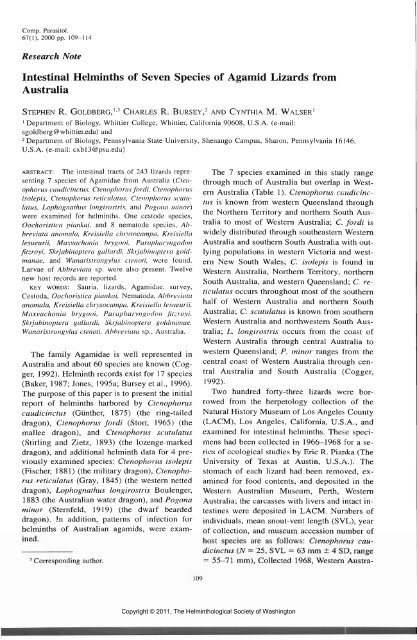Comparative Parasitology 67(1) 2000 - Peru State College
Comparative Parasitology 67(1) 2000 - Peru State College
Comparative Parasitology 67(1) 2000 - Peru State College
You also want an ePaper? Increase the reach of your titles
YUMPU automatically turns print PDFs into web optimized ePapers that Google loves.
Comp. Parasitol.<br />
<strong>67</strong>(1), <strong>2000</strong> pp. 109-114<br />
Research Note<br />
Intestinal Helminths of Seven Species of Agamid Lizards from<br />
Australia<br />
STEPHEN R. GOLDBERG,'-3 CHARLES R. BURSEY," AND CYNTHIA M. WALSER'<br />
1 Department of Biology, Whittier <strong>College</strong>, Whittier, California 90608, U.S.A. (e-mail:<br />
sgoldberg@whittier.edu) and<br />
2 Department of Biology, Pennsylvania <strong>State</strong> University, Shenango Campus, Sharon, Pennsylvania 16146,<br />
U.S.A. (e-mail: cxbl3@psu.edu)<br />
ABSTRACT: The intestinal tracts of 243 lizards representing<br />
7 species of Agamidae from Australia (Ctenophorus<br />
caudicinctus, Ctenophorus fordi, Ctenophorus<br />
isolepis, Ctenophorus reticulatus, Ctenophorus scutulatus,<br />
Lophognathus longirostris, and Pogona minor)<br />
were examined for helminths. One cestode species,<br />
Oochoristica piankai, and 8 nematode species, Abhreviata<br />
anomala, Kreisiella chrysocampa, Kreisiella<br />
lesueurii, Maxvachonia brygooi, Parapharyngodon<br />
fitzroyi, Skrjabinoptera gallardi, Skrjabinoptera goldmanae,<br />
and Wanaristrongylus ctenoti, were found.<br />
Larvae of Abbreviate* sp. were also present. Twelve<br />
new host records are reported.<br />
KEY WORDS: Sauria, lizards, Agamidae, survey,<br />
Cestoda, Oochoristica piankai, Nematoda, Abbreviata<br />
anomala, Kreisiella chrysocampa, Kreisiella lesueurii,<br />
Maxvachonia brygooi, Parapharyngodon fitzroyi,<br />
Skrjabinoptera gallardi, Skrjabinoptera goldmanae,<br />
Wanaristrongylus ctenoti, Abbreviata sp., Australia.<br />
The family Agamidae is well represented in<br />
Australia and about 60 species are known (Cogger,<br />
1992). Helminth records exist for 17 species<br />
(Baker, 1987; Jones, 1995a; Bursey et al., 1996).<br />
The puipose of this paper is to present the initial<br />
report of helminths harbored by Ctenophorus<br />
caudicinctus (Giinther, 1875) (the ring-tailed<br />
dragon), Ctenophorus fordi (Storr, 1965) (the<br />
mallee dragon), and Ctenophorus scutulatus<br />
(Stirling and Zietz, 1893) (the lozenge-marked<br />
dragon), and additional helminth data for 4 previously<br />
examined species: Ctenophorus isolepis<br />
(Fischer, 1881) (the military dragon), Ctenophorus<br />
reticulatus (Gray, 1845) (the western netted<br />
dragon), Lophognathus longirostris Boulenger,<br />
1883 (the Australian water dragon), and Pogona<br />
minor (Sternfeld, 1919) (the dwarf bearded<br />
dragon). In addition, patterns of infection for<br />
helminths of Australian agamids, were examined.<br />
3 Corresponding author.<br />
109<br />
The 7 species examined in this study range<br />
through much of Australia but overlap in Western<br />
Australia (Table 1). Ctenophorus caudicinctus<br />
is known from western Queensland through<br />
the Northern Territory and northern South Australia<br />
to most of Western Australia; C. fordi is<br />
widely distributed through southeastern Western<br />
Australia and southern South Australia with outlying<br />
populations in western Victoria and western<br />
New South Wales; C. isolepis is found in<br />
Western Australia, Northern Territory, northern<br />
South Australia, and western Queensland; C. reticulatus<br />
occurs throughout most of the southern<br />
half of Western Australia and northern South<br />
Australia; C. scutulatus is known from southern<br />
Western Australia and northwestern South Australia;<br />
L. longirostris occurs from the coast of<br />
Western Australia through central Australia to<br />
western Queensland; P. minor ranges 1'rom the<br />
central coast of Western Australia through central<br />
Australia and South Australia (Cogger,<br />
1992).<br />
Two hundred forty-three lizards were borrowed<br />
from the herpetology collection of the<br />
Natural History Museum of Los Angeles. County<br />
(LACM), Los Angeles, California, U.S.A., and<br />
examined for intestinal helminths. These specimens<br />
had been collected in 1966-1968 for a series<br />
of ecological studies by Eric R. Piarika (The<br />
University of Texas at Austin, U.S.A.). The<br />
stomach of each lizard had been removed, examined<br />
for food contents, and deposited in the<br />
Western Australian Museum, Perth, Western<br />
Australia; the carcasses with livers and intact intestines<br />
were deposited in LACM. Numbers of<br />
individuals, mean snout-vent length (SVL), year<br />
of collection, and museum accession number of<br />
host species are as follows: Ctenophorus caudicinctus<br />
(N = 25, SVL = 63 mm ± 4 SD, range<br />
= 55-71 mm), Collected 1968, Western Austra-<br />
Copyright © 2011, The Helminthological Society of Washington
















